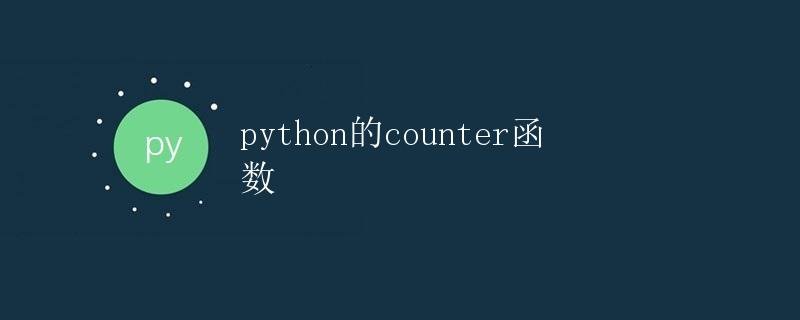Python’s Counter function
Python’s Counter Function

In Python, Counter is a tool for counting the number of elements in an iterable. It is a class in the collections module. Counter returns a dictionary where the key is the element and the value is the number of times the element appears in the iterable. In this article, we will introduce the usage of the Counter function in detail and provide examples.
1. Basic Usage of the Counter Function
First, we need to import the Counter function:
from collections import Counter
Next, we can use Counter to count the number of elements in a list:
# Create a list
lst = [1, 2, 3, 1, 2, 3, 4, 5, 1]
# Use Counter to count the number of elements in a list
count = Counter(lst)
print(count)
Running result:
Counter({1: 3, 2: 2, 3: 2, 4: 1, 5: 1})
As can be seen in the example above, the Counter function returns a dictionary where the keys are the elements in the list lst and the values are the number of times that element occurs in the list.
2. Advanced Uses of the Counter Function
2.1 Using Counter to Count the Number of Characters in a String
In addition to lists, the Counter function can also be used to count the number of characters in a string:
# Create a string
s = "hello world"
# Use Counter to count the number of characters in a string
count = Counter(s)
print(count)
Running result:
Counter({'l': 3, 'o': 2, 'h': 1, 'e': 1, ' ': 1, 'w': 1, 'r': 1, 'd': 1})
2.2 Count word occurrences using Counter
We can also use Counter to count word occurrences in a sentence:
# Create a sentence
sentence = "I love Python. Python is the best programming "language."
# Split the sentence into a word list
word_list = sentence.split()
# Use Counter to count the number of word occurrences
count = Counter(word_list)
print(count)
Running result:
Counter({'Python.': 1, 'Python': 1, 'is': 1, 'the': 1, 'best': 1, 'programming': 1, 'language.': 1, 'I': 1, 'love': 1})
3. Common Methods of the Counter Function
The Counter function also provides some common methods for manipulating statistical results. </p> method returns an iterator where each element is repeated a given number of times. You can loop through each element:
<h3>3.1 Elements Method</h3>
<p><code>elements
count = Counter([1, 2, 2, 3, 3, 3, 4, 4, 4, 4])
# Get an iterator of elements and their repetition counts
elem_iter = count.elements()
for elem in elem_iter:
print(elem)
Running result:
1
2
2
3
3
3
4
4
4
4
3.2 most_common method
most_common method returns a list of elements sorted by the number of occurrences. You can specify to return the top N elements with the highest number of occurrences:
count = Counter([1, 2, 2, 3, 3, 3, 4, 4, 4, 4])
# Return the two elements with the highest number of occurrences
top_two = count.most_common(2)
print(top_two)
Running result:
[(4, 4), (3, 3)]
3.3 update method
update method is used to update the count from another iterable object. If a dictionary is passed in, the count will be reset to the value in the dictionary:
count1 = Counter([1, 2, 2, 3, 3])
count2 = Counter([1, 2, 3, 4, 4, 4])
# Merge two counters
count1.update(count2)
print(count1)
Running result:
Counter({1: 2, 2: 3, 3: 3, 4: 3})function, including its basic and advanced uses, as well as common methods. The<h2>4. Summary
<p>This article introduced the Python <code>Counter
Counterfunction is a very convenient tool that can help us quickly count the number of elements in an iterable object. In practical applications, we can use theCounterfunction to easily perform various statistical tasks and improve programming efficiency.